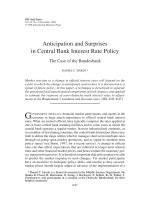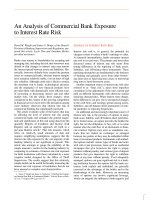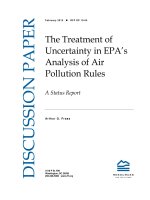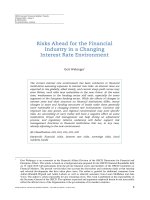EFFECTS OF INCREASING IN FED’S INTEREST RATE ON THE EMERGING MARKETS
Bạn đang xem bản rút gọn của tài liệu. Xem và tải ngay bản đầy đủ của tài liệu tại đây (1.18 MB, 26 trang )
THE EFFECTS OF INCREASING IN
FED’S INTEREST RATE ON THE
EMERGING MARKETS
Truong Van Hung
신천의
1.Introduction
The FED announced to withdraw the QE (quantitative
easing) in Oct 29th, 2014 and will increase the intreast
rate.
How it will affact the EMEs?
The recent ecomonic performance in EMEs.
Why is the Fed considering rising interest rates now?
How does the global market affect the Fed’s decision?
How an interest rate hike would affect emerging market?
2.The recent economic performance in
EMEs
The BRICs:
Represent over 42% of the world population.
Combined nominal GDP of US$16.039 trillion.
It is estimated that the combined GDP (PPP) would
reach US$50 trillion mark by 2020.
The recent economic performance
in EMEs
China
Stock market reaches a new low in this September.
Chinese economy grew an annual 6.9 percent in the
third quarter of 2015, slightly down from 7.0 percent.
GDP growth of
China (YoY)
The recent economic performance
in EMEs
Brazil
The 7th largest economy in the world and the largest in Latin
America.
The country’s trade is driven by its extensive natural resources
and diverse agricultural and manufacturing production.
Bureaucracy, corruption and weak infrastructure remain the
biggest obstacles to economic development.
The recent economic performance
in EMEs
Russia
The largest country in the world and the 5th largest
economy.
In 2014, following military intervention in Ukraine,
prospects for economic growth declined further.
The recent economic performance
in EMEs
South Africa
Advanced 1 percent year-on-year in the third quarter of
2015.
The recent economic performance
in EMEs
India
Expanded 7.4 percent year-on-year in the three months
to September of 2015.
The recent economic performance
in EMEs
Most of the EMEs in a difficult economic situation.
Russian and Brazilian economies are falling into deep
recession.
Russian and Brazilian economies are falling into deep recession.
Indian economy is presently operating in a very challenging
environment partly.
3-Why is the Fed considering rising
interest rates now?
The current performance of US economy
The Real GDP growth (based on 2009 dollars) grew by 3.7%
during the second quarter and by 2.1% in 3nd quarter 2015.
3-Why is the Fed considering
rising interest rates now?
Unemployment rate is within the target range.
FED's goal: To keep
unemployment rate between
5.2% - 5.5% in long-run.
The trailing 12 months
unemployment rate is 5.5%,
which is still satisfactory.
3-Why is the Fed considering
rising interest rates now?
Current level of US interest
rate.
The US was hit by the crash in
its housing market and
banking sector between 2007
and 2009.
It's been nearly 10 years since
the FED raised its benchmark
interest rate.
US economy has been
improving
4- How does the global market affect the
Fed’s decision
The slowdown in Chinese economy & EMEs as well
Falling Commodity Prices
Slowing Global Demand
9-13
4- How does the global market affect the
Fed’s decision
The slowdown in Chinese economy & EMEs as well
The stock market turmoil (fluctuated wildly)
9-14
4- How does the global market affect the
Fed’s decision
The slowdown in Chinese economy & EMEs as well
China devalued Yuan against $ to boost the export.
9-15
4- How does the global market affect the
Fed’s decision
Falling Commodity Prices: because of slowing Chinese
& global demand for Commodity US inflation rate.
9-16
4- How does the global market affect the
Fed’s decision
Falling Global Demand
Brazilian & Russian Economies Fall into Deep Recession.
Euro Zone is still struggling to get out of deflation.
9-17
5- How an interest rate hike would affect
emerging market
Capital flight ( flight to quality)
Triggering global debt crisis
Copyright © 2008 Pearson Addison-Wesley. All rights reserved.
9-18
5-1. Capital Flight
Capital flight (flight to quality)
moving capital away from
riskier investments to the
safest investment vehicles.
The recovery of US economy Higher
interest rate.
Economic slowdown/ Recession & the currency devaluation in
EMEs.
Investments in US market promise safer & higher return
than in EMEs & FMEs.
Encourage further capital outflows from EMEs, FME to
U.S. markets.
Copyright © 2008 Pearson Addison-Wesley. All rights reserved.
9-19
Capital flows to EMEs
Copyright © 2008 Pearson Addison-Wesley. All rights reserved.
9-20
5-2. Triggering global debt crisis
The majority of emerging market debt is in US dollars due to
Loose money policy in central bank to stimulus the economies after
crisis in US.
Ultra-low interest rate
Copyright © 2008 Pearson Addison-Wesley. All rights reserved.
9-21
High debt in both
advanced economies and EMEs
Copyright © 2008 Pearson Addison-Wesley. All rights reserved.
9-22
5-2. Triggering global debt crisis
According to WB:
Dollar loans to EMEs
have doubled to $3 trillion
since the Lehman Brother
crisis.
Borrowing at abnormally
low real interest rate of
1%
Roughly 80% of the dollar
debt in China is on shortterm maturities
EMEs balance sheets in
red due to the economic
contraction & recession
Copyright © 2008 Pearson Addison-Wesley. All rights reserved.
9-23
What will happen:
Global debt crisis coming soon???
According to The Bank for International Settlement
(BIS):
The global financial system remains anchored to US borrowing
rate
Fed raises interest rate
higher borrowing cost & EMEs may face a monetary shock.
9-24
Summary
• The Fed’s rate rise could exacerbate the EM currency
turmoil, and even help precipitate a full-blown crisis.
• An increase in Fed’s interest rate can trigger a global
debt crisis in the near future.









